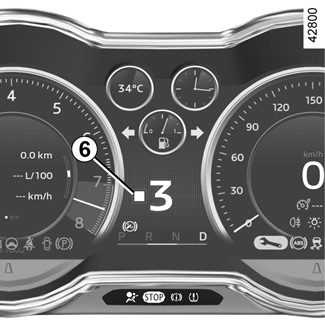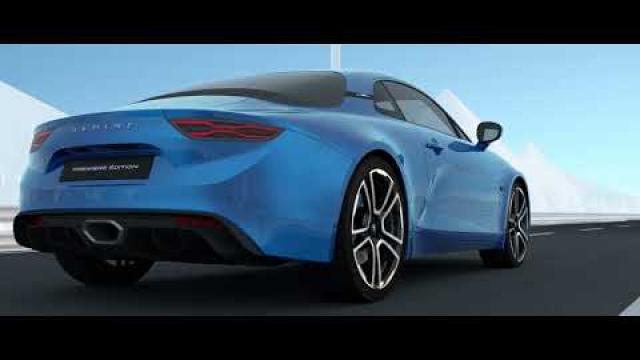AUTOMATIC TRANSMISSION



Selection controls
Switches R, N and D can be used to select the various gearbox positions:
- (R) position: reverse;
- (N) position: neutral;
- (P) position: park;
- (D) position: drive driving in automatic mode;
- (M) position: manual driving in manual mode.
The 5 display on the instrument panel shows the position and the indicator 4, shows which gear is engaged.
Gear changing paddles 1 and 2
Paddles 1 and 2 can be used to change gear when the gearbox is in “manual mode” position (M) or in “automatic mode” position (D).
1 Decrease switch for gear (-).
2 Increase switch for gear (+).
Positions (P), (N) and (R) cannot be accessed using the paddles.
Operation
With the vehicle stopped, ignition switched on and electronic parking brake applied, the warning lights integrated into switches R, N and D disappear.
Gearbox in position (P) or (N), with your foot on the brake pedal (3 warning light disappears from the instrument panel), start the engine.

To disengage the “Parking” position (P)
With the vehicle at a standstill, engine running, depress the brake pedal and select the desired position (R), (N), (M) or (D).
Gearbox positions (R), (N), (D) or (M) should only be engaged when the vehicle is stopped, with your foot on the brake, the accelerator pedal released and the engine running.
If the brake pedal is not fully depressed, the 3 warning light appears on the instrument panel.
Note:
- If the driver opens their door to leave the vehicle while position (P) has not been engaged, a beep sounds and the message “P not engaged” is displayed on the instrument panel.
- The warning light 3 appears each time it is necessary to depress the brake pedal to change the automatic gearbox position.
To engage the “Parking” position (P)
With the vehicle stationary, engine running or the ignition on, press and hold the switch N until the indicator light integrated into switch N appears in red. P is displayed on the instrument panel. The gearbox goes into Park position (P).
Note: when the engine is switched off by pressing the button, position (P) is automatically engaged as well as the electronic parking brake, for those vehicles equipped with it. The indicator light on the N control appears in red and P is displayed on the instrument panel.
When you select position (D), (M) or (R), the vehicle moves forward as soon as you release the brake pedal (without pressing on the accelerator pedal).
Check that warning light P on the instrument panel and the red warning light integrated into the N switch are activated before leaving the vehicle.
Risk of loss of immobilisation of the vehicle.
If the message “Check auto gearbox” or “Electric failure DANGER” is displayed, or in the event of a battery fault, immobilise the vehicle using the electronic parking brake.
Contact an approved dealer as soon as possible.
To engage neutral (N)
With the vehicle stationary, engine running, press the brake pedal and briefly press switch N (the N switch integrated warning light appears in white and N is displayed on the instrument panel).
Note: when positions (R), (M) or (D) are engaged, it is not necessary to depress the brake pedal to engage position (N).
An impact to the underside of the vehicle while manoeuvring (e.g. striking a post, raised kerb or other street furniture) may result in damage to the vehicle (e.g. deformation of an axle).
To avoid any risk of accident, have your vehicle checked by an approved Dealer.
Driving in automatic mode: position (D)
With the vehicle stationary, engine running and position (P), (N) or (R) engaged, press the brake pedal and briefly press switch D (the D switch integrated warning light appears in white and D is displayed on the instrument panel).
If one of these conditions is not met, the D warning light flashes for approximately five seconds and the 3 warning light remains displayed on the instrument panel.
Note: with the engine running, the vehicle moving and (D) position engaged, it is possible to change to manual driving mode (M) by a single press on the D switch (the warning light built into the D control appears in blue and M is displayed on the instrument panel).
For most road conditions, you will not need to touch the switches: gears will change automatically and optimally according to the depression of the accelerator pedal, the driving style chosen and the road type.
Note: with the engine running and the vehicle travelling between 0 and 6.2 mph (0 and 10 km/h), in position (N) or (R), it is not necessary to depress the brake pedal to engage position (D). This is useful during parking manoeuvres requiring a number of alternate forward and reverse movements.
When you select position (D), (M) or (R), the vehicle moves forward as soon as you release the brake pedal (without pressing on the accelerator pedal).
Economical driving
When driving, always leave the gearbox in position (D), keeping the accelerator pedal lightly depressed to ensure automatic gear changes at a lower engine speed.
Accelerating and overtaking
Depress the accelerator pedal briskly and fully (so that it goes beyond the kickdown point).
This will enable you to change down to the optimum gear within the engine range.
Driving in temporary manual mode
The temporary manual mode can be used when the automatic mode (D) has previously been engaged.
It is possible to force gear changes (temporary manual mode), by operating the paddles:
- to move down through the gears, press the left-hand paddle;
- to move up through the gears, press the right-hand paddle.
The gear selected is displayed on the instrument panel.
Note: the gearbox returns to automatic mode:
- If no action has been taken on either of the paddles for more than 5 seconds;
- If you press the D switch again;
- If you press and hold the right-hand paddle.
Special cases
In certain driving conditions (e.g. engine protection mode, operation of the electronic stability program ESC), the automated system may change the gear automatically.
The requested gear will be maintained for a period set by the system, based on the gradient and the driving style.
The system will take over once this period has elapsed and may then trigger an automatic gear change.
Likewise, to prevent incorrect manoeuvres, a gear change may be refused by the automatic system: in this case the engaged gear flashes on the instrument panel for a few seconds as a warning.
When facing uphill, to remain stopped, do not keep your foot on the accelerator.
Risk of overheating the automatic gearbox.
Driving in manual mode: position (M)
With the vehicle stationary, engine running and position (P), (N) or (R) engaged, press the brake pedal and briefly press on switch D (the D control integrated indicator light appears in white and D is displayed on the instrument panel). To change to position (M), briefly press on the D switch (the D control integrated indicator light appears in blue M and is displayed on the instrument panel).
Repeatedly shifting the paddles allows you to change gears manually:
- to move down through the gears, press the left-hand paddle;
- to move up through the gears, press the right-hand paddle.

The gear selected is displayed on the instrument panel.
Note: Engine running, vehicle moving, position (M) engaged, it is possible to change to automatic driving mode (D) by a single press on the D switch (the D control integrated indicator light appears in white and D is displayed on the instrument panel).
Gear changing threshold indicator
When the 6 indicator is displayed on the instrument panel:
- in white with dashes, the gear engaged complies with the engine speed;
- in red with accompanied by a beep, this indicates the need to change up a gear;
- with , this indicates the need to change to a lower gear.
In “Track“ mode, the gearbox will switch to permanent manual mode (M).
To switch to automatic driving mode (D), select mode “Normal“ or “Sport“ (see “Choice of driving mode” in Section 2).
Special cases
In certain driving modes (e.g. protecting the engine), a gear change may be performed automatically if there is a risk of over-revving or approaching under-revving. The manual mode remains activated.
Similarly, to avoid making the “wrong move”, a gear change may be refused by the gearbox. In this case, the display for the engaged gear flashes for a few seconds to warn you.
Multiple downshifting
Depending on the vehicle and the if the “Sport“ or “Track“ driving mode is activated (refer to the “Choice of driving mode” in Section 2), it may be possible to quickly downshift several gears.
With the gearbox in position (M) and the brakes on, press and hold the left-hand paddle as many times as is necessary for the gears to automatically descend to the optimal gear.
Parking the vehicle
When the engine is switched off by pressing the button, position (P) is automatically engaged as well as the electronic parking brake, for those vehicles equipped with it. The indicator light on the N control appears in red and P is displayed on the instrument panel.
When the vehicle is stopped with the engine running, press and hold switch N until the N switch integrated indicator light appears in red. The gearbox switches to parking position (P).
Special case
As position (P) is automatically engaged when the engine is stopped, it is sometimes necessary to place the vehicle in position (N), for example in some car washes or when the vehicle is being transported.
With the engine off, ignition on, doors closed and gearbox in position (P), it is possible to switch to position (N) by a short press on the N switch while simultaneously depressing the brake pedal (the N switch integrated indicator light appears in white and N is displayed on the instrument panel).
(N) position may be engaged before the driver’s door is opened and for a maximum of around 45 seconds after the engine has stopped. After this time or after opening the driver’s door, it will be necessary to turn on the ignition again to disengage position (P).
Note: Once activated after the engine is switched off, position (N) is retained until the next time the ignition is switched on.
Never leave your vehicle without setting the gearbox to P position and switching off the engine.
This is because when the vehicle is stationary with the engine running and a gear engaged, the vehicle may begin to move.
There is a risk of accidents.
Special feature of the “Stop and Start” function: if you unfasten the driver’s seat belt before the “Stop and Start” function puts the engine into standby, make sure the gearbox is in (P) position. The P warning light will light up on the instrument panel to confirm this. Risk of loss of immobilisation.
If information disappears from the instrument panel, stop and immobilise the vehicle using the electronic parking brake or in parking position (P) by pressing and holding the N button (the N switch integrated indicator light appears in red with the engine running).
To select reverse gear
With the vehicle stationary, engine running and in position (P), (N), (M) or (D), press the brake pedal and briefly press the R switch (the R control integrated warning light appears in white and R appears on the instrument panel).
The reversing lights will come on as soon as the reverse gear is selected (ignition on) and, depending on the vehicle, the reversing camera will be activated (refer to “Rear View Camera” in Section 2).
If the brake pedal is not pressed down, the R warning light flashes for approximately five seconds and the 3 warning light remains displayed on the instrument panel.
Note: with the engine running and the vehicle travelling between 0 and 6.2 mph (0 and 10 km/h), in position (N) or (D), it is not necessary to depress the brake pedal to engage position (R). This is useful during parking manoeuvres requiring a number of alternate forward and reverse movements.
Special circumstances
If the bends and road surface do not allow you to stay in automatic mode (e.g. in the mountains), we recommend that you change to manual mode.
This will prevent the automatic gearbox from changing gear repeatedly when climbing, and permit engine braking on long descents.
Maintenance period
Refer to the maintenance document for your vehicle or consult an Approved Dealer to check whether the automatic gearbox requires scheduled maintenance.
If it does not need to be serviced, there is no need to top up the oil.
Operating faults
- when driving, if the “Check auto gearbox” message appears on the instrument panel, this indicates a fault.
Immobilise the vehicle using the electronic parking brake.
Contact your Approved Dealer as soon as possible;
- when driving, if the message “Gearbox overheating” appears on the instrument panel, stop as soon as possible to let the gearbox cool down and wait for the message to disappear;
- for repairs to a vehicle with an automatic gearbox, refer to the “Towing” paragraph in chapter 5.
For safety reasons, do not switch off the ignition before the vehicle has come to a complete standstill.
